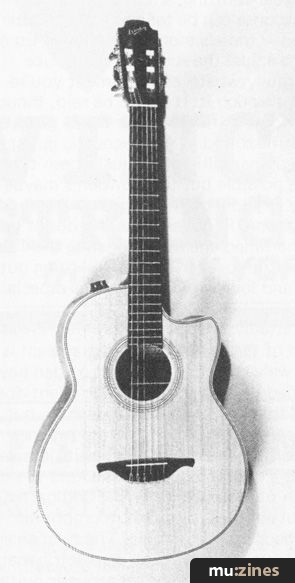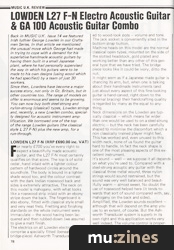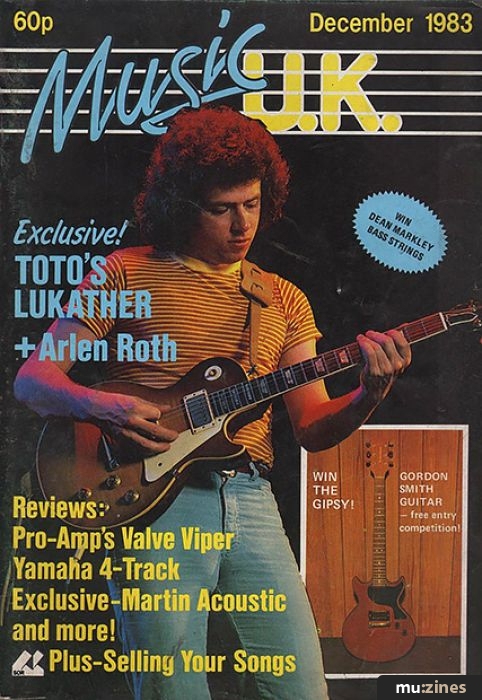Magazine Archive
Home -> Magazines -> Issues -> Articles in this issue -> View
Lowden L27 F-N Electro Acoustic Guitar & GA 100 Acoustic Guitar Combo | |
Article from Music UK, December 1983 | |
Loud an' Proud?....
Back in MUSIC U.K. Issue 14 we featured Irish luthier George Lowden in our Craftsmen Series. In that article we mentioned the unusual move which George had made in trying to cope with a demand for his superlative handmade acoustic guitars by having them built in a small Japanese plant, where he had personally supervised the way in which his guitars were to be made to his own designs (using wood which he had specified) by a team of just 30 workers.
Since then, Lowdens have become a major success story, not only in Gt. Britain, but in other countries too. The range of models on offer is enormous and seems to be growing. You can now buy both steel-strung and nylon-strung (classical) types, Lowden strings and, recently, a new Lowden combo, specially designed for acoustic instrument amplification. We borrowed one of the top of the range Lowden guitars (the classical style L 27 F-N) plus the new amp, for a run-through.
LOWDEN L27 F-N (RRP £690.00 inc. VAT)

For nearly £700 you've every right to expect a beautifully made acoustic guitar, and the L27 F-N most certainly qualifies on that score. The top is of solid cedar, hand inlaid with a lighter colour pattern of hardwood circles around the soundhole. The body is bound in a lighter shade wood too, and the colour contrast with the dark Indian rosewood back and sides is extremely attractive. The neck on this model is mahogany, with what looks like a rosewood strip inlaid with an ebony stripe down the back. The fingerboard is also ebony, fitted with classical style small and very neat frets. Fretting and finishing standards on the whole instrument were immaculate — the wood having been lacquered and then rubbed-down (we assume) to give a matt finish.
The electrics on all Lowden electro-acoustics comprise a specially fitted (beneath the bridge-piece) Ashworth Transducer, connected to wood-look pots — volume and tone. The jack socket is conveniently sited in the bottom strap button.
Machine heads on this model are the normal classical open types, mounted on the side of the slotted headstock, gold plated and working better than any other of this general type that we have tried. The bridge piece looks like it could be ivory, ditto the nut.
It might seem as if a Japanese made guitar is chancing its arm, but, when one is talking about their handmade instruments (and just about every aspect of this fine-looking guitar is hand-carved, right down to the internal bracing) their handcrafting quality is regarded by many as the equal to anything.
Neck dimensions on the Lowden are typically classical — which means far wider than one would be used to on a steel-strung electric — but the neck has been carefully shaped to minimise the discomfort which a non classically trained player might feel. This has worked and, even unused to this width neck, none of us found the guitar hard to handle. In fact the neck shape is one of the most pleasing aspects of this excellent instrument.
It's sound — well — we suppose it all depends on what you're used to. Compared with a steel-strung acoustic any guitar with the classical three metal wound, three nylon strings would sound restrained, but the sound was very well balanced and beautifully warm — almost sweet. No doubt the use of rosewood helped here (it tends towards that sort of sound compared with, say, mahogany on the back and sides). Amplified, the Lowden sounds excellent — although that will depend on the amp you use to an extent, of course. But the Ashworth Transducer system is superb in its own right and this application works very well indeed. The volume control is properly progressive and the tonal range is really wide — enabling you to create an enormous variety of sounds from the instrument.
Overall the main benefits of this model appear to be the really superb neck, beautiful manufacturing quality, a nicely balanced warm sound and that intangible feel of total 'luxury'. Minus points? Well it's hard to say. If you're used to a steel-strung acoustic and that's the sort of sound you're looking for then, of course, this won't be the model for you — but there are numerous other models in the range which offer steel strings (and the ones we've tried have been every bit as good as this one). If, on the other hand, you want a classical guitar and intend to use it amplified then this must rate as one of the very best available. For the right player it's an amplifiable guitar almost out on its own in terms of quality and sound — not to mention its playability. By the way, if the price seems to be beyond you, there are, thankfully, cheaper Lowden models available — one which springs to mind is similar (using not quite so much in the way of luxury materials, but still a fine guitar) which sells for £250 less. Overall verdict? The Lowden is a peach of a guitar!
LOWDEN GA 100 (RRP £355.00 inc. VAT)

While most electro-acoustic players use conventional guitar amps, few are ideal for the job. The problems of amplifying, say, an acoustic guitar or mandolin (not to mention a violin) are a combination of a) reproducing the sound accurately and b) controlling feedback — the latter being virtually unavoidable with acoustics.
One answer comes from the Lowden guitar people, who have developed their own transistorised 100 watt combo, designed to cope with both of these problems.
First things first — the looks. Well, cosmetics are always very much a matter of personal taste but, to us at least, we can't say that this one appealed to us very much. The colour combinations, alone — well, ('Fiona is wearing this month's shade of amp covering: - puce green with yellow polka-dots') Actually, the amp's covering is a brown tough quality vinyl, the control panel a light blue and the speaker baffle board looks like it's been faced in a pine-coloured Formica. How one reacts to this, er, unusual colour and materials combination is a personal business but the Formica-type laminate is potentially fragile and would, we suspect, show a few marks after much time on the road. The speaker, on the other hand, is well protected with a screw-on metal grille, so it's only cosmetic damage that would show, but it would be a pity. Anyway, onto the facilities. The back panel has an I.E.C. plug-in mains connector, the on/off switch and a comprehensive selection of jack sockets — suggesting that this amp has been designed for professional use. You have an effects loop pair (for send and return), line out, phones out and two extension speaker outputs.
The front panel reveals two channels with one input for each. Channel one has bass, mid and treble controls, Channel Two, the same. Next there's a 5-band graphic, offering cut and boost on 100, 200, 400, 800 and 1,600 Hz. Reverb is controlled by two push buttons (on/off for each channel) plus a reverb depth control. This is switchable by a footswitch, the jack socket for which comes next. After that there's a master volume control and, finally, a Cannon socket for a D.I. feed — a useful (and very professionally orientated) facility.
From an acoustical point of view, the front baffle board sports two large holes, indicating that the cabinet (it's a sealed back type, by the way) has been designed to function in a tuned, ported reflex manner.
We tested the Lowden amp with both a Lowden guitar and a Manson Sandpiper, fitted with an Ashworth transducer. Sound with both was impressive, although care had to be taken with the graphic equaliser, which seemed best suited for removing feedback stimulating frequencies rather than as an extended tone control — although it could be gently 'tweaked' to get the sound reasonably close to that of the original instrument. From a tonal point of view the Lowden is probably best described as a warm-sounding amp. It's got impressive volume, without being ear-splitting, and the overall warmth of response can be tailored to any basic sound — there's more than enough Eq on tap to adjust the sound to reproduce accurately whatever instrument you're using through it. It has to be said, though, that no amplifier will ever really give you the same sound as your acoustic guitar played unamplified — it just doesn't seem to be possible but the Lowden's maybe as close as you'll get — it's got a natural depth and timbre in its response (no doubt helped by the tuned enclosure assisting the 12" McKenzie speaker) which will bring out the bass and lower-mid frequencies especially well.
Regrettably, we couldn't say that the application of the spring-line reverb system is the best we've heard. Probably Lowden have decided that an acoustic instrument doesn't need the depth an electric might — but we're not so sure.
On balance, the Lowden does its job well. It has a natural depth in its sound (a slight touch of 'boxiness', maybe) and particularly useful abilities to squash microphonic feedback via the graphic. The twin channels enable you to have, say, an electric mandolin in one channel and an acoustic guitar in the other. Overall, Lowden have got their ideas on facilities right and the sound is very good. The problem is, however, that the amp comes out at a hefty price — especially bearing in mind the single 12" speaker they've chosen to use. £355 is rather a lot to ask for any 100watt transistorised 1x12" combo — however well provided with facilities. So, although we appreciate the amp's qualities and facilities it's hard to see how we could describe it as anything other than rather poor value for money. Maybe if the makers dropped the, no doubt costly, wood look on the front panel, and possibly simplified the facilities, a semi-pro model could be put on the market at a more attractive price? As it stands you'd have to think long and hard about whether it was really worth this sort of money to you.
Publisher: Music UK - Folly Publications
The current copyright owner/s of this content may differ from the originally published copyright notice.
More details on copyright ownership...
Review
Help Support The Things You Love
mu:zines is the result of thousands of hours of effort, and will require many thousands more going forward to reach our goals of getting all this content online.
If you value this resource, you can support this project - it really helps!
Donations for May 2024
Issues donated this month: 0
New issues that have been donated or scanned for us this month.
Funds donated this month: £0.00
All donations and support are gratefully appreciated - thank you.
Magazines Needed - Can You Help?
Do you have any of these magazine issues?
If so, and you can donate, lend or scan them to help complete our archive, please get in touch via the Contribute page - thanks!






